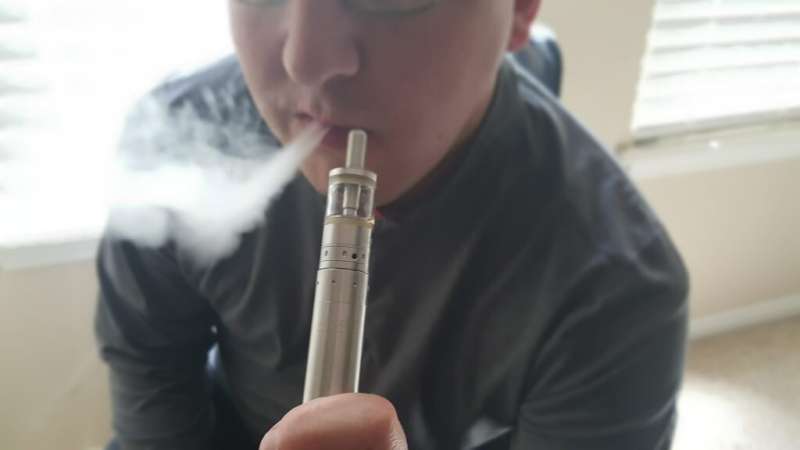Credit: Wikimedia Commons
Whether you're doing vape tricks for YouTube views or kicking yourself for not realizing that "USB" was actually your teenager's Juul, you know vaping is all the rage right now. You probably also know that President Trump has called on the FDA to ban all flavored e-cigarettes to combat youth vaping. This comes in reaction to the mysterious lung illness that has affected 1,080 people to date. 18 of them have died.
At Duke Law School's "Vaping: Crisis or Lost Opportunity" panel last Wednesday, three experts shared their views.
Jed Rose, a professor of psychiatry and behavioral sciences and director of the Duke Center for Smoking Cessation, has worked in tobacco research since 1979, focusing on smoking cessation and helping pioneer the nicotine patch. Rose also directs Duke's Center for Smoking Cessation.
According to Rose, e-cigarettes are more effective than traditional Nicotine Replacement Therapy (NRT). A recent study found that e-cigarettes were approximately twice as effective as the state-of-the-art NRT in getting smokers to quit combustible cigarettes (CCs). This makes sense because smokers are addicted to the action of puffing, so a smoking cessation tool that involves inhaling will be more successful than one that does not, like the patch.
Rose also took issue with the labeling of the current situation surrounding vaping as an "epidemic." He called it a "crisis of exaggeration," then contrasted the 18 deaths from vaping to the 450 annual deaths from Tylenol poisoning.
Even in the "pessimistic scenario," where e-cigarettes turn out to be far more harmful than expected, Rose said deaths are still averted by replacing cigarettes with e-cigarettes.
The enemy, Rose argued, is "disease and death, not corporations", like the infamous (and under-fire) Juul.
James Davis, MD, an internal medicine physician and medical director for the Center for Smoking Cessation, works directly with patients who suffer from addiction. His research focuses on developing new drug treatments for smoking cessation. Davis also spearheads the Duke Smoke-Free Policy Initiative.
Davis began by calling for humility when using statistics regarding e-cigarette health impacts, as long-term data is obviously not yet available.
Davis did present some known drawbacks of e-cigarettes, though, stating that e-cigarettes are similarly addictive compared to conventional cigarettes, and that a whopping 21 percent of high school students and 5 percent of middle school students use e-cigarettes. Davis also contended that "When you quit CCs with e-cigarettes, you are merely transferring your addiction to e-cigarettes. Eighty-two percent [of test subjects who used e-cigarettes for smoking cessation] were still using after a year."
However, according to Davis, there is a flipside.
Similar to Rose, Davis looked to the "potential for harm reduction"—e-cigarettes' morbidity is projected to be only 5-10 percent that of CCs. If the main priority is to get smokers off CC, Davis argues e-cigarettes are important: 30-35 percent of CC smokers say they would use an e-cigarette to quit smoking, where only 13 percent would use a nicotine patch.
Furthermore, Davis questioned whether the mysterious lung disease is attributable to e-cigarettes themselves—a recent study found that 80 percent of a sample of afflicted subjects had used (often black-market) THC products as well.
Lauren Pacek, an assistant professor in psychiatry and behavioral sciences at Duke, examines smoking in the context of addiction and decision-making.
Pacek stated that flavored electronic nicotine delivery systems (ENDS) are important to youth: 61-95 percent of current youth ENDS users use flavored products, and 84 percent of young users say they would not use the products without flavors. So, banning flavored ENDS would ostensibly reduce young adults' use, potentially keeping them off nicotine entirely.
However, Pacek pointed to the importance of flavors for adult users too: the ones that are purportedly using ENDS not for recreation or social status (as young people have been known to do), but for smoking cessation. Many former CC smokers report that flavored ENDS were important for their cessation. By banning flavored ENDS, the products look less appealing, and smokers are more likely to return to much more harmful cigarettes.
So where do we go from here?
Pacek did not take a concrete stance, but said her "take-home message" was that policymakers need to consider the impact of the ban on the non-target population, those earnest cigarette smokers looking to quit, or at least turn to a less harmful alternative.
Rose also did not offer a way forward, but made clear that he does not support the FDA's impending ban on flavored e-cigarettes and thinks the hysteria around vaping is mostly unfounded.
Davis did not suggest a course of action for the U.S., but as leader of Duke's Smoke-Free Policy Initiative, he certainly suggested a course of action for Duke. The Initiative prohibits combustible forms of tobacco at Duke, but does not (yet) prohibit e-cigarettes.
More information: Peter Hajek et al. A Randomized Trial of E-Cigarettes versus Nicotine-Replacement Therapy, New England Journal of Medicine (2019). DOI: 10.1056/NEJMoa1808779
Jennifer E. Layden et al. Pulmonary Illness Related to E-Cigarette Use in Illinois and Wisconsin—Preliminary Report, New England Journal of Medicine (2019). DOI: 10.1056/NEJMoa1911614
Journal information: New England Journal of Medicine
Provided by Duke University
























